Figure 2. Analysis of Readiness Evaluation and Discharge Interventions (READI) Effectiveness for Intervention Units With Low (≤11.3%) and High (>11.3%) Readmission Rate at Baseline.
Difference-in-differences predictive margins with 95% CIs (error bars) of the absolute percentage point reduction from the READI intervention by protocol, estimated using a multinomial conditional likelihood difference-in-differences logistic model with adjustment for baseline event rates and patient characteristics with clustering at unit and hospital level. The READI1 protocol used the nurse form of the Readiness for Hospital Discharge Scale (RHDS) with instructions to nurses to use their best judgment with the assessment information to guide actions in completing their patients’ preparation for discharge. The READI2 protocol used patient self-assessment using the patient form of the RHDS followed by nurse assessment using the nurse form of the RHDS with instructions to nurses to use their best judgment. The READI3 protocol used patient self-assessment using the patient form of the RHDS followed by nurse assessment using the nurse form of the RHDS with instruction to nurses to act and document nurse actions if the patient received a low readiness score (<7) on the nurse or patient form. ED indicates emergency department.

